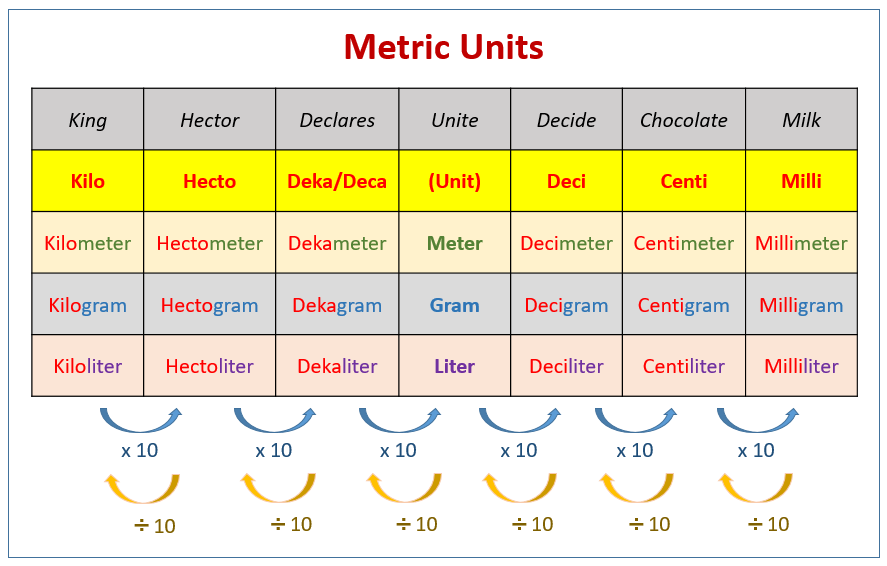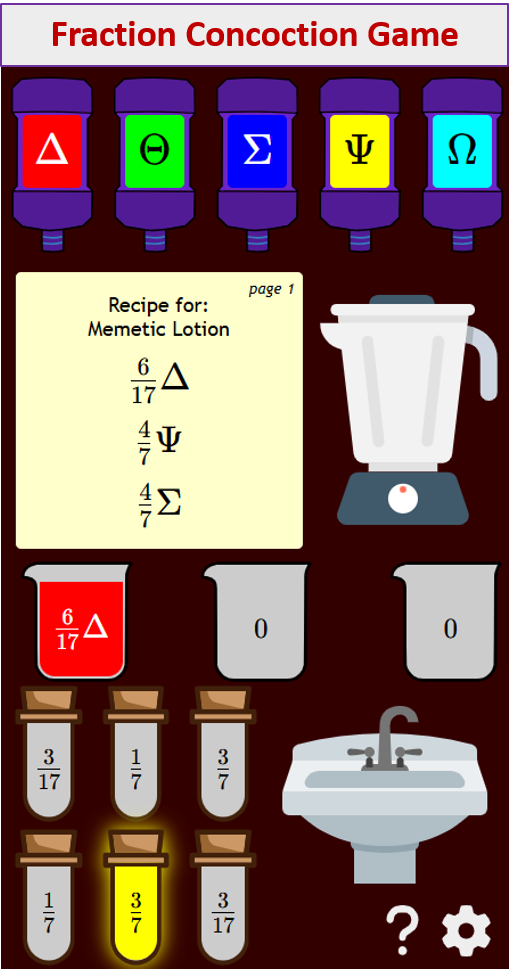Metric Unit Measurement
Related Pages
Metric Unit Measurements 2
More Lessons for Grade 6 Math
Math Worksheets
These lessons, with videos, examples, solutions and worksheets, will help Grade 6 students learn about metric unit measurement and conversion. They will learn:
- What is the metric system?
- How to convert metric units?
What is the metric system?
The metric system is a decimal system of measurement based on powers of 10, which makes conversions between units very straightforward. It’s designed to be logical and easy to use.
The metric system (International System of Units, SI) uses a set of prefixes to denote multiples and submultiples of its base units (like meter, gram, liter, second, etc.). These prefixes are powers of 10, meaning each prefix is 10 times larger or smaller than the next.
The following diagram shows the prefixes used for the metric system and how to remember them. Scroll down the page for more examples and solutions on how to convert between the metric units.

Measurement Worksheets
Practice your skills with the following worksheets:
Printable & Online Measurement Worksheets
Measurement Worksheets
Practice your skills with the following worksheets:
Printable & Online Measurement Worksheets
| Free Measurement Games Online | |
|---|---|
| Metric Conversion | Customary Measurement Conversion |
Conversion Shortcut: The Ladder Method
Imagine these as steps on a ladder or a number line.
Kilo (103)
Hecto (102)
Deka (101)
Base unit (meter, gram, liter) (100 or 1)
Deci (10−1)
Centi (10−2)
Milli (10−3)
How to Convert:
- Identify your starting unit and your target unit.
- Locate both units on your “ladder” or list of prefixes.
- Count the number of “steps” (or decimal places) between the two units.
- Determine the direction:
Moving to a smaller unit: Multiply by powers of 10 (move the decimal point to the right).
Moving to a larger unit: Divide by powers of 10 (move the decimal point to the left).
Examples:
-
Converting from a Larger Unit to a Smaller Unit (Multiply / Move Decimal Right)
a) Convert 2.5 meters (m) to centimeters (cm):
From “meter” (Base) to “centimeter” is 2 steps to the right.
So, move the decimal 2 places to the right.
2.5 m = 250 cm
b) Convert 0.4 kilograms (kg) to grams (g):
From “kilo” to “gram” (Base) is 3 steps to the right.
So, move the decimal 3 places to the right.
0.4 kg = 400 g
c) Convert 1.2 kilometers (km) to millimeters (mm):
From “kilo” to “milli” is 6 steps to the right (3 to base, then 3 more to milli).
So, move the decimal 6 places to the right.
1.2 km = 1,200,000 mm -
Converting from a Smaller Unit to a Larger Unit (Divide / Move Decimal Left)
a) Convert 750 milliliters (ml) to liters (L):
From “milli” to “liter” (Base) is 3 steps to the left.
So, move the decimal 3 places to the left.
750 ml = 0.750 L
b) Convert 34.5 centimeters (cm) to meters (m):
From “centi” to “meter” (Base) is 2 steps to the left.
So, move the decimal 2 places to the left.
34.5 cm = 0.345 m
c) Convert 89,000 grams (g) to metric tons (t):
This one uses “tonne” (metric ton), which is equal to 1000 kg.
First, convert grams to kilograms: From “gram” (Base) to “kilo” is 3 steps to the left.
89,000 g = 89.000 kg = 89 kg
Now, convert kilograms to metric tons: 1 metric ton = 1000 kg. So, divide by 1000 (move decimal 3 places left).
89 kg = 0.089 t
Videos
Introduction to the Metric System This video gives and introduction to the Metric System.
Converting distance measurements
mm, cm, m, km.
How to convert between these.
The process used to convert between the various metric units of measure.
It includes two examples.
Converting Between Metric Units
This video covers the process for converting between metric units of measure. It includes 4 examples.
Metric Unit Conversions
Students learn that in the metric system, all measures of length are based on meters.
Try out our new and fun Fraction Concoction Game.
Add and subtract fractions to make exciting fraction concoctions following a recipe. There are four levels of difficulty: Easy, medium, hard and insane. Practice the basics of fraction addition and subtraction or challenge yourself with the insane level.

We welcome your feedback, comments and questions about this site or page. Please submit your feedback or enquiries via our Feedback page.